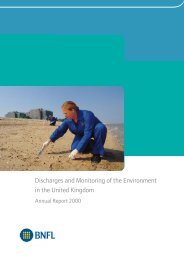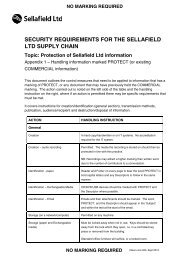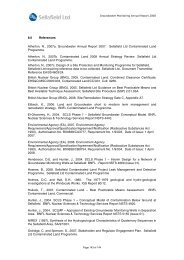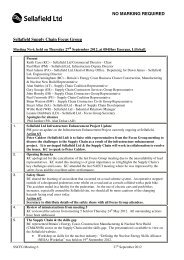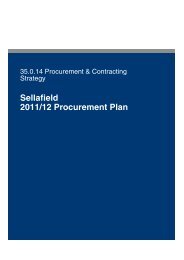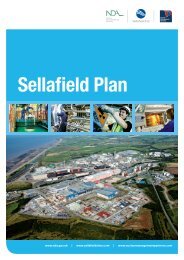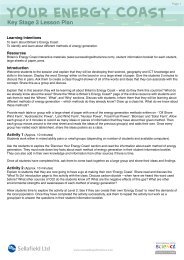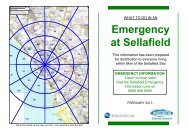Annual Report for 2010/11 and Forward Programme - Sellafield Ltd
Annual Report for 2010/11 and Forward Programme - Sellafield Ltd
Annual Report for 2010/11 and Forward Programme - Sellafield Ltd
Create successful ePaper yourself
Turn your PDF publications into a flip-book with our unique Google optimized e-Paper software.
SSEM/20<strong>11</strong>/4730 June 20<strong>11</strong>6. Aims <strong>and</strong> Objectives6.1 Introducing the requirement <strong>for</strong> large area beach monitoringThe 2008 Summary <strong>Report</strong> (Hemming, 2008) provides details on some of the background<strong>and</strong> drivers that led to the introduction of a regulatory requirement <strong>for</strong> large area beachmonitoring at <strong>Sellafield</strong>. The report also sets out how the early programme <strong>for</strong> beachmonitoring developed.In brief, the detection, recovery <strong>and</strong> analysis of a particle containing 90 Sr, during routinemonitoring of the str<strong>and</strong>line on <strong>Sellafield</strong> beach in 2003, triggered a review of beachmonitoring operations. This review <strong>and</strong> subsequent trial of a vehicle mounted system in late2006 / early 2007 resulted in an evolving programme that has seen the development <strong>and</strong>deployment of state-of-the-art detection equipment across a wide extent of the beaches onthe coast of West Cumbria.During the early programme, it was not known whether radioactive particles were present insignificant numbers <strong>and</strong> over what geographical range. Based on early modelling work, thefirst trials took place in areas where the highest chance of encounter had been predicted, tothe immediate north of the <strong>Sellafield</strong> site. As material was detected <strong>and</strong> recovered from thislocation; so the programme started to include beach areas that are more distant from the<strong>Sellafield</strong> site. This has resulted in monitoring being carried out on sections of all the mainstretches of accessible beach along the West Cumbrian coast; <strong>and</strong> has included beaches onthe north Solway.Consistent with the aim of underst<strong>and</strong>ing the geographic range <strong>and</strong> distribution of particlenumbers, the specified area to be monitored increased as the programme developed. The<strong>Sellafield</strong> trial covered an area of 9.2 ha, followed by a 26 ha trial at Braystones (usingvehicle-mounted <strong>and</strong> h<strong>and</strong>-held equipment). The success of the trials led to the inclusion ofa specification in the Compilation of Environment Agency Requirements (CEAR) requiring “aminimum beach area of 15 ha …by 31 July 2007, with a minimum area of 100 ha to besurveyed by 31 March 2008”. In fact, the total area monitored during 2007/08 was in excessof 150 ha, against a revised specified area of 146.7 ha.Success in achieving what may be described as arbitrary target areas, effectively led to abeach monitoring programme of 250 ha per year. Year-on-year, the total area coverageactually achieved has exceeded the target, with last year’s coverage area totalling c.319 ha.These totals are corrected to take account of the overlap that is built into the vehiclemonitoring swathes to ensure that contiguous coverage is achieved. The specified area <strong>for</strong>monitoring has essentially evolved based on operational per<strong>for</strong>mance, as determined by therequired detection capability of the equipment; the natural constraints presented by work in abeach environment (beach accessibility, beach substrate, tidal window, available daylightetc); <strong>and</strong> the priority given to public protection <strong>and</strong> assurance. SL considers that 250 ha peryear represents the working capacity of the current system (Softrak running Synergy at1m/s), allowing <strong>for</strong> minimum down-time periods <strong>for</strong> vehicle maintenance <strong>and</strong> buffer time.6.2 Beach monitoring programme reviewThe early specification <strong>for</strong> <strong>Sellafield</strong> beach monitoring was heavily influenced by the workbeing done at Dounreay, where fragments of fuel are being detected in the environment. Asthe <strong>Sellafield</strong> programme has evolved it has become evident that the situation at <strong>Sellafield</strong> issufficiently different to that at Dounreay; <strong>and</strong> presents a number of unique challenges,including the types <strong>and</strong> relative distribution of contaminated material. As a consequence the© Nuclear Decommissioning Authority 20<strong>11</strong>. 84



